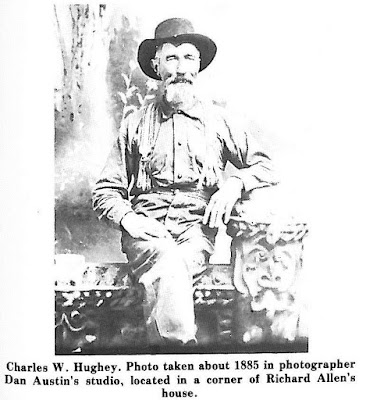Sunday Stories: George Arnold and the Post Office
Excerpted from: One Hundred Years on the South Loup
Since 1876, mail destined for this part of the Loup valley
was brought by horseback every two weeks from Plum Creek and addressed “Arnold
& Ritchie Ranch, c/o Postmaster.” The partners had taken turns handling the
mail – now a change would have to be made. Allen offered to have the post
office in his sod house and on March 21, 1881, he, with Landis Correll and
George Arnold, met to choose a name for the new office. “Correll” was
considered, so was “Allen,” finally “Arnold” was chosen and a letter sent off
to Washington for a new rubber stamp.
George Arnold, partially paralyzed from a stroke suffered
the year before, probably never knew the little office given his name ever
developed into a town. He went back to the family home in Ohio, where he died
in 1900, leaving no relatives in Arnold. Later residents by the same name had no
connection.
Before entering the cattle business, Arnold had served in
the Civil War and married Ella Taylor, daughter of Edward Taylor, editor of the
Omaha Bee and one-term governor of the state by appointment. The Arnolds had
four children, one a baby when they came to the ranch - the only baby in the
country.
Charles W. Hughey, cowboy, cook and general handyman, came
up the Loup with cattlemen San Ritchie and George Arnold, in 1877, and worked
for them and other ranchers. He was a familiar sight around the country, riding
his horse, Redbird, followed by two black dogs. It was “Grandpa” or “Uncle”
Hughey, as he was called, who discovered the body of the trapper frozen in
Powell Canyon. When Arnold and Ritchie left the country in the spring of ’81,
they sold the 320 acre ranch headquarters to Hughey. Soon after he moved into
the log cabin, it caught fire and was hastily pulled down to save the red cedar
logs. It was from this land Hughey, in 1884, donated a small plot to be used as
a cemetery, when Dora, the small daughter of miller John Koch, died.
Hughey himself was soon buried there, killed in 1893 when a
hay knife pierced his chest in a fall from a hayrack. His grave can be seen
along the cemetery’s west fence, with its headstone engraved as being a gift from
the town of Arnold. His wife had died before he came to Arnold, but G. J.
Hughey, in Arnold in 1883, may have been his son.
By early summer, would-be settlers were coming in a steady
stream. The Custer County Republican reported: “A gentlemen from over on the
South Loup informs us that from Sunday afternoon until afternoon of the
following day he counted fifty-two teams – land hunters – heading for the head
of the Loup.”
Homeseekers coming up the dusty river valley would camp near
the Allens for a few days or weeks, while their men scouted out the surrounding
country and stepped off 160 acres in places that would be called Powell Canyon,
Yucca Valley, Mills Valley, Kilmer Valley, Milldale, Cedar Grove, Loyal and
Pleasant Hill.
Not all who came, of course, filed on land, and of those who
did, many could not take the hardships, or starved out before proving up,
leaving the claim open for the next comer. A survey done years later showed an
average of two and a half filings on each quarter in Custer County.
There were three ways of acquiring public land. The
Homestead Act of 1862 gave 160 acres to the head of a household who would live
on it for five years and make certain improvements; the Preemption Act of 1841
gave 160 acres to any man who would live on it, erect a dwelling and after
proving up, pay the government $1.25 an acre. It was possible for him to
preempt an adjoining quarter at the same time he was homesteading another.
The third way was by the Tree Claim Act (Timber Culture Act) passed in the early
1870s, giving 160 acres to a settler who would plant 40 acres of trees and
cultivate them for eight years. These requirements were later reduced, but even
still, were impossible to fulfill due to natural conditions. The act failed in
its intentions to forest a barren land and was repealed in 1894, but for a
time, it was possible for an ambitious settler to gain title to 480 acres of
public land.
Allen added a tree claim to his holdings later and wrote in
1936: “Most men on tree claims allowed the weeds to grow as high as the trees
and they never had a chance. I think that is why we see so many dwarfed patches
of underbrush around Arnold today.” He had attacked the problem of lack of
trees the first summer by setting out the fine grove that would furnish shade
and shelter for almost eighty years. The last of these trees were taken out a
few years ago to make room for the swimming pool.





790A146D56
ReplyDeletetakipçi satın al
Gerçek Takipçi
Online Oyunlar
Fake Takipçi
MMORPG Oyunlar